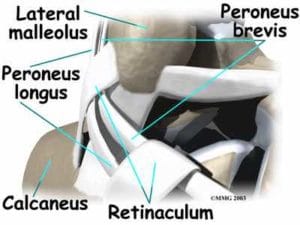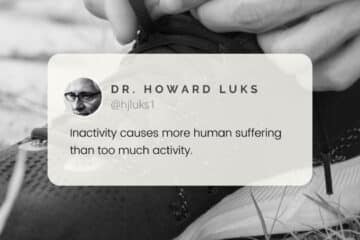
The peroneal tendons are located on the outer side of your ankle. The tendons are firmly held in place in a groove behind your fibula. If the peroneal tendons slide out of the groove then you will have pain due to peroneal tendon subluxation. How do we diagnose and treat peroneal tendon subluxation. As Gareth Bale will be able to attest to, the recovery from peroneal tendon subluxation can last for months.

What Is Peroneal Tendon Subluxation?
As noticed in the diagram, the two peroneal tendons are held in place by a strong piece of tissue we call a retinaculum. If the retinaculum tears then the two peroneal tendons can subluxate or move in front of the fibula. The most common cause of peroneal tendon subluxation is an ankle sprain. During an inversion ankle sprain (the most common type) the tissues on the outside of your ankle are stretched. At the same time your tendons are pulling hard to resist that motion. That can put a lot of stress on the retinaculum holding the two tendons in place. Ultimately the retinaculum can tear or lift off the fibula and allow the peroneal tendons to subluxate or move towards the front of your ankle.
What are the symptoms of peroneal tendon subluxation?
The common symptom of peroneal tendon subluxation is a painful popping sensation on the outer side of your ankle. At the time of the injury or ankle sprain you may not notice the tendons are out of place. Especially because the entire outside of your ankle may now be swollen. As the swelling subsides, you will now notice that the tendons subluxate when you move your ankle upwards. The peroneal tendons do not stay subluxated. So they will go back into place when you move your foot downward. The tendons do not need to subluxate each and every time you move the ankle. Sometimes this will only occur with forceful motion and rotation, such as running around on a soccer field or basketball court.
How Do You Diagnose Peroneal Tendon Subluxation?
The diagnosis of peroneal tendon subluxation is generally very straightforward. Your Orthopedic Surgeon will ask you to move your ankle into certain positions. That will usually cause the peroneal tendons to subluxate which will be easy for us to feel. In situations where it isn’t clear we may need to obtain an MRI which will show us whether or not the retinaculum is torn or separated from the fibula.
How Do You Treat Peroneal Tendon Subluxation?
Gareth Bale will likely have surgery to repair his peroneal tendon dislocation. Do all cases of this require surgery? The short answer is no. If the injury is acute or fresh, then there is a chance that the retinaculum will heal if the foot is casted so the tendons stay in their normal position. If this treatment is unsuccessful then peroneal tendon subluxation is treated by fixing the retinaculum which holds the tendons in place. In many cases we are simply reattaching the retinaculum to the fibula. This is an open surgery. At the time of the surgery we also inspect the two tendons to be sure there is no evidence of a peroneal tendon tear. If a tear is noted then the tendon will be fixed at the same time that the retinaculum is repaired.
What is the Recovery From Peroneal Tendon Subluxation?
After the repair we need to give the retinaculum time to heal back to the bone. That healing process can take many months. Physical therapy will usually start within 4-6 after surgery to start to improve your motion. After months of strengthening, conditioning and sports specific training the retinaculum should have the strength and stability to allow you to return to play.
Do you have questions regarding an Orthopedic injury or longevity?
Do you want to talk to an expert who can listen to you for 45-60 minutes and explain the options in detail?
Dr. Howard Luks offers remote guidance sessions to review your X-ray or MRI images and explain your options.
Dr. Luks has also received hundreds of requests for educational sessions on the topics discussed in his book, Longevity Simplified.












Equestra
Have you seen fibular subluxation at both knee and ankle before? I’m a 46yo athlete who after several meniscectomies had to have a TKR. I felt a huge shift in my bones about 6 weeks post surgery, which progressed to pain and popping upon heel strike walking, to almost constant motion and pain / burning while active. My ROM never came along as it should have either, and changed based on which direction my bone has popped (it subluxes backward / toward calf). OS hasn’t seemed to think this is an issue. I’m researching before getting a second opinion. Hoping there’s a conservative option for me.
I have seen many cases of proximal tib-fib joint subluxations. Many people choose to live with it or have a proximal tib/fib joint fusion.
J Buback
Hello,
I had surgery for this 30 years (specifically superior reticinaculum repair, I’m sure I messed that up, so sorry) and after a long recovery I have done wonderfully, until this weekend. My ankle rolled while I was doing something I do daily and I heard a pop. It has been swollen and painful, just as I remember the first time. Can an initial repair be re-injured? If so, do I treat it like a new injury? Thank you!
HI J …
Hopefully, this was just an ankle sprain and not a retinacular tear as you had 30 years ago. some of these injuries will heal without surgery if the ankle is immobilized soon enough. I have not personally seen someone tear this twice…
Owen
I know you won’t be able to diagnose my exact issue but I’d like your opinion anyway. I’m a 52 year old male. I was a 5 mile a day runner for 23 years. In 2012 I developed a heart condition that required a pacemaker. After recovering from that surgery a few months later I attempted to return to running. I ran 7 miles the night before my pacemaker surgery. My left ankle won’t go more than a quarter mile before giving out now. The pain sorta starts burning in the outside of the shin down to just above the ankle. At about 3/4 mile the ankle stops working all together. Other than several rollover ankle injuries on that same foot I had no significant injury. It just doesn’t work. Since then my ankle hurts at rest constantly. Driving. Sitting on a chair or couch. I’m constantly moving it to dull the pain. I’m unable to get an mri. CT scans and X-rays show nothing other than a thickening around the peroneal tendon. Long distant drives are grueling. I ride a Harley but rarely now because of the discomfort that is constant. The strangest thing is that I can ride a stationary bike till my ass is numb. 20 to 25 miles for an hour at a time. Elliptical too. But I can’t walk around the block. Also about 3 inches below my left knee there’s an indentation that travels across my shin bone from inside the knee to the outside of my calf and down toward the ankle. There’s pain and twitching in this area frequently. I have extremely poor dorsaflex in the same ankle also. Any advice before I let someone open my leg to fix something that isn’t broke. My non expert research combined with what I’m experiencing kind of makes me feel it could be some nerve entrapment somewhere in my lower leg. The discomfort and pain while at rest is extremely difficult to deal with. Thank you sir for taking the time to read this.
Perhaps this post below might help you. This is not medical advice, but can be used to guide questions with your doctors.
Good Luck
https://www.howardluksmd.com/orthopedic-social-media/peroneal-nerve-leg-pain/
Deidre
Hello,
I’ve been experiencing something similar for some time. When I stretch my left foot, I hear and feel multiple cracks and can see the tendon move. This sometimes happens in my right foot, but it’s definitely more prominent in my left. It can really be painful, as well. I’m seeing a foot doctor next week. Do you think it can be Peroneal Tendon Subluxation?
I don’t know… a good examination can tell you, so you should find out next week. Good luck
Trish
I didn’t realize until now that this seems to be what I experience several times a year. It just happened tonight as I stepped out of the car. It lasted for about an hour until I got home. I flexed and stretched my foot in various directions and actually watched as the tendon moved back into place. It’s extremely painful when it’s stuck. I do remember a pretty bad sprain over 10 years ago. Is this something I should have checked out? I mean, will it eventually happen more frequently?
THanks!
It will not get better on its own. Best to have it looked at because over time, if the tendons are subluxating they might start to tear.
Je
I have rolled my ankle a week before my basketball game and used rice(rest,ice,compression,evaluation). So, I rest that whole week and it felt fine until my last two games: where I’m just normally walking down the court like literally walking down the court my ankle pops and I get a pain which only last for a couple seconds and Im fine after that. Until my last game where it popped 3 Times during my game the last pop it was hard for my to walk or stand on it until I sat down and rest it felt fine, but I was scared to walk on it and put pressure on it so I just sorta limped and since then It keeps on doing the same thing even though I’m walking normally to the kitchen or at work. So, Idk what to do?
Persistent ankle popping following a sprain should prompt an examination with a sports medicine doctor. If you do have peroneal tendon subluxation you should not be playing until it is treated.
Karl
Hi,
I play volleyball and have had numerous ankle sprains to both of my ankles over the span of five years. Almost two weeks ago, I sprained my right ankle very badly for the second time in my life. The pain I experienced during the injury was the worst I’ve ever endured, and I did hear a cracking noise, but it sounded like a knuckle was cracking- it didn’t sound like a broken bone. Also, the bruising and swelling is the worst I have ever experienced in a sprain- black & blue from lower leg to my toes- but I could walk with no pain three days after the sprain happened. I’ve been icing twice a day for 2 weeks, but for the past week, the swelling has not gone down and it looks like there is a golfball on the outside of my ankle. One last thing- my ankle feels to be popping out of place and quickly popping back into place, like a shoulder popping in and out of place really quick. When it pops out of place, it hurts a ton. I began looking at symptoms and descriptions of peroneal tendon subluxation and they sounded right, but when I looked at videos of it, it doesn’t match what I’ve been experiencing.
I’m honestly just very confused and I’m going to ask my athletic trainer about it tomorrow and possibly see my podiatrist soon. If you have any insights please share.
Thank you!
Kari…
You should see an Orthopedic and Sports Medicine doc to have your ankle properly evaluated.
Good luck
Trish
Would you recommend a 50 yo female who enjoys daily trail hiking, or jogging on uneven ground, wear an ankle brace? If so, what sort? She has a Hx of recurrent L ankle inversion sprains as a high school/intercollegiate athlete. She now suffers moderately painful peroneal tendon subluxation occurring intermittently w/dorsiflexion of the L foot, approx 4x/month, both while wt bearing & non. There is no noticible swelling. She reports feeling a snap at the tendon, then like “it is stuck out of its groove, & won’t go back in”. It does not resolve w/movement or massage, but resolves spontaneously w/rest over ~10-60 mins. She does not want surgical intervention unless absolutely necessary. So, other than the strengthening & flexibility exercises she is doing, I am wondering if in your opinion, an ankle brace during sports might provide any benefit?
Thank you for all the time you put into this wonderful website, sharing your perspective & wealth of experience w/us. It’s beneficial to both pts & providers alike!
HI Trish…
Braces or sleeves typically do not work for a subluxing tendon… but it can’t hurt to try one. As long as it isn’t too tight.
Shana
I have rolled and sprained my ankle numerous times. A few months ago something started popping out of place often, when I’d go downstairs. When it happens it feels like something inside is unstable, and the pain is pretty bad. It hurts behind my ankle, especially when I id try to walk, specifically when id push off with the ball of my foot. But if I kinda kicked my foot a few times it would resolve. However now it seems to be happening at random times and often stays out for several hours, and when it happens it is too painful to use the foot at all. My ankle is also now chronically swollen. There’s a bit of pain most of the time but generally only unbearable when the popping happens. My MD suspects the peroneal tendon is subluxing and I’m awaiting xray results….sincerely hoping it’s not as my primary job is a dog walker!
good luck… We wish you well.
Kunle Ajayi
Hello Dr,
Thanks for your post. It was very enlightening. I have had popping and snapping as well as pain in my right ankle for over 2 years now. The pain becomes excruciating when I walk, however I noticed that I feel less pain with new footwear. After a week though, I return to experiencing the pain more intensely and walking becomes very difficult. I soon realized that the increase in pain was partly induced by the wearing off of the right side of the sole of my right shoe. Consequently, I fixed a steel plate on the sole…and this seemed to make walking more tolerable…at least until the steel plate wear off too. Fast forward. . …the orthopedic surgeon I saw recently said the MRI scan did not show anything wrong. …that my tendons were ok. Although this was good news…it hasn’t changed my situation. He suggested I should use the shoes that cause me intense pain…and let my ankle get imflammed and then have another MRI scan…that way he can really see what is going on. I was wondering if you wouldn’t mind sharing your thoughts on this problem.
Peroneal tendon subluxation is seen on the physical examination. The MRI might show a loose retinaculum… and in advanced cases it might shows small tears in the tendon. But this is a diagnosis which reveals itself on examination every time. Perhaps you can seek another opinion? Perhaps you can find an Orthopedic Surgeon who specializes in Ankles. They are out there.
Good luck
ch ch
I never sprained my ankle (that I know of) and my ankles and other joints have always cracked like to the extreme whenever I move and now I have an ache in my outer left ankle especially after it pops or snaps, should I see someone? would this still be peroneal tendon subluxtion or something else?
Hi … Not all cases of snapping or popping on the lateral side of the ankle is due to the peroneal tendons. You may want to see your doctor for an examination…it’s usually very easy to tell if the peroneal tendons are responsible for the snapping.
John mcpherson
I landed hard on my ankle over 2 years ago. My doctor did not see a clear injury at the time and sent me away. Sine then, I have not been able to walk or run for long periods and I can crack my ankle repeatedly after a day of work. It also appears swollen. My doctor has now performed an X-ray and MRI, but is not seeing anything. I am frustrated and my ankle is always sore. I need relief as this is affecting my agility to enjoy life.
What do I do next?
See a second opinion … and perhaps an Orthopedic Surgeon who specializes in Foot and Ankle surgery.
Rachel
Sounds like tendinitis
Sierra
I sprained my ankle about two months ago then I rolled it in pe and I heard it pop or snap ever since then it will do the pop or snap and I can feel it and sometimes u can hear it it will do it over and over again should I be concerned
If the popping is because of the peroneal tendons then it is something that might require treatment. I would see an Orthopedic Surgeon who can help you.